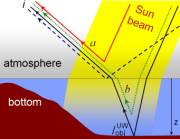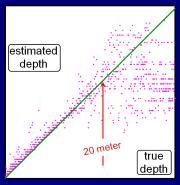Yoav Y. Schechner: Research
Spaceborne Computational Photography

The Multi-angle Imaging SpectroRadiometer (MISR) is a spaceborne instrument developed by NASA's Jet Propulsion Laboratory (JPL). As MISR orbits, it captures high quality radiometrically and geometrically calibrated multispectral images of Earth, from multiple directions. Over time, the orbiting instrument achieves lightfield imaging (integral-imaging) of Earth. This enables development of computational photography methods on a planetary scale, as well as retrieval of atmospheric and surface parameters. Multi-angular imaging of Earth is an evolving technology, progressing towards enhanced resolution and polarization sensitivity.
Based on this concept, one direction which we pursue is remote underwater imaging. Shallow waters are very important for human and biological activity. Remote sensing of these areas is challenging, as it requires separation of ocean (or lake) bottom, water and atmospheric effects. We propose a concept and theory for spaceborne recovery of the underwater depth map, optical characteristics of the water and atmosphere, and the descattered ocean bottom. The sensing is based on multi-angular geometry and polarization. An orbiting platform captures a subspace of the Earth’s light field, which is sensitive to the atmospheric and water characteristics. Consequently, it is possible to invert the image formation process using the acquired data. Recovery is simplified using recent findings about natural characteristics of deep water backscatter and surface transmissivity. It also exploits accumulated historical sounding data.
Publications
- Yoav Y. Schechner, David J. Diner and John V. Martonchik, “Spaceborne underwater imaging,” Proc. IEEE ICCP (2011).
Presentations
- “Spaceborne underwater imaging” (4.5 Mb, PowerPoint). These are the slides of a presentation given at ICCP'12. The talk (oral presentation) accompanying the slides can be viewed in this link (begining 22:38 minutes from the start of the video).



